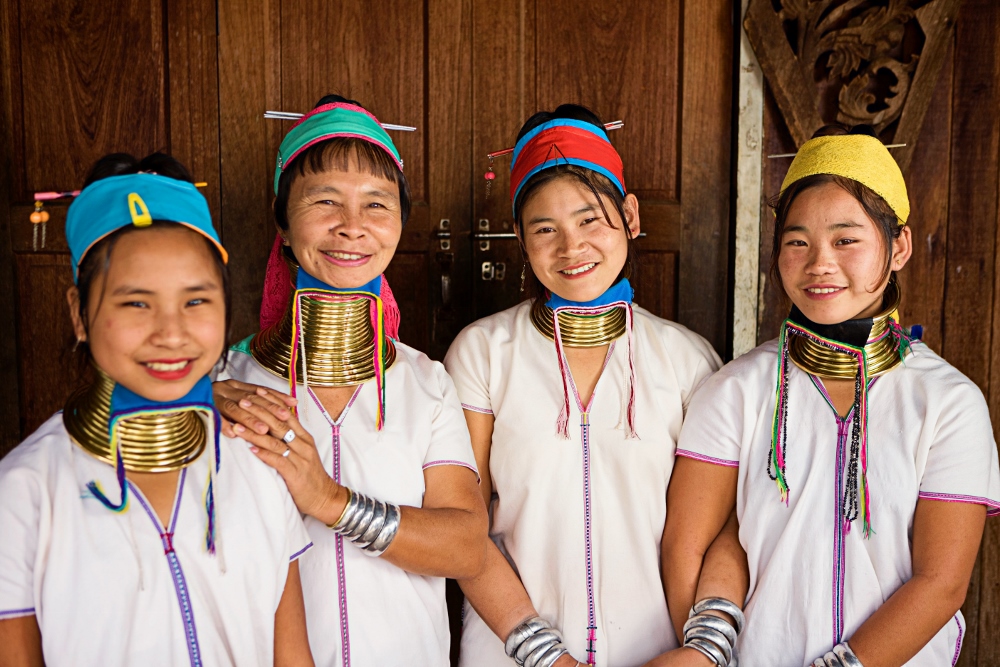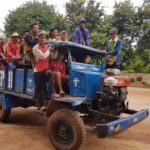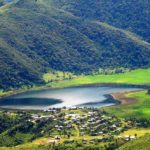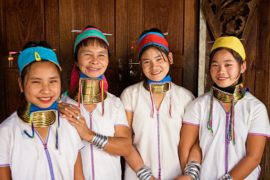Tourism is helping to draw back members of the Kayan community from Thailand- including women famed for wearing brass coils on their necks.
Mu Baw returned to Pan Pet, her small village in Kayah state, from Thailand four months ago. “I am happy to be back. Life was difficult in Thailand” said the mother of five.
Mu Baw is ethnic Kayan. The group is also known as Padaung – a Shan term – or the “long-necked women” for the brass coils that they wear around their neck.
With few work opportunities in her tiny village in this quiet corner of the country. Mu Baw spent more than five years in Thailand, close to the northern city of Chiang Mai, employed in the tourism industry. Visitors would come and watch her kit scarves.
“Growth in the tourism industry following economic and political reforms has prompted many of the Kayan women living in Thailand to consider returning home. Mu Baw estimated about three quarters of her village are still across the border, though.”
One of nine Kayah ethnic groups, the Kayan are known around the world for the distinctive neck rings worn by their women. In 1935 a group of Kayan women (known then by the politically women’’) toured around the United Kingdom, often forming part of circuses – a popular form of entertainment in Britain before the outbreak of World War II.
In one famous photo, the three women are standing on a street in London, being given directions by a police officer as three gentlemen behind them – in matching jackets and bowler hats – look in, bemused.
Growth in the tourism industry following economic and political reforms has prompted many of the Kayan women living in Thailand to consider returning home. Mu Baw estimates about three quarters of her village are still across the border, though.
A US$1.9 million project, led by international Trade Centre, that was launched in 2014, and aims to promote Kayah State as a tourism destination is also helping the community. The program has a range of elements. It trains villagers like Mu Baw to make handicrafts, such as scarves, figurines and jewellery , which can then be sold to visitors.
ITC has also introduced full-day and half-day tours to Pan Pet, which is a two-hour drive from Loikaw, the Kayah State capital. The half-day tour includes a guide around the shops and a short lesson in how the women make their craft. The full-day tour includes the same, plus a few hours’ trekking through the nearly forests with a knowledgeable guide.
Mu Tha is also benefiting from the ITC program. But unlike Mu Baw, she never left to go to Thailand. “All my children, they have left – either working in Thailand or Yangon. But I never wanted to leave my home.” Said Mu Tha, whose husband died three years ago. “My children come back sometimes, but as you can see there is not much to do here.”
She said she is happy with the ITC program. Her mother taught her how to weave scarves, but until the program began very few visitors came to the village so she rarely sold anything. It is not like Pan Pet is being swamped by tourists. The ITC program aims to ensure that tourism development in Kayah State is sustainable, and Kayah state remains difficult to access. “There has been a bit of an increase in visitors recently, but not too much” said Mu Baw. “I’m happy with the small increase.”
Kayah’s ethnic kaleidoscope
It might be the smallest and least-populated region of Myanmar, but Kayah state is also among the most ethnically diverse. While some of its groups are well-known – even outside the country – others are barely known even amongst Myanmar people, and can consist of just a few thousand people.
The state is officially home to eight Kayah sub-groups, many of which go by multiple names. The largest is the Kayah, also known as the Karenni and the group that gives the state its name. Others include the Gheko, Ghebar, Kayan, Bre, Manu Manaw, Yin Baw and Yintale. Most have alternative names but some are pejorative titles foisted on them by other ethnic groups.
Most, if not all of the Kayah sub-groups are closely related to the Kayun: indeed, Karenni means Red Karen. The Languages and dialects spoken by ethnic groups in Kayah state are in the S’gaw Kayin language family.
When members of different ethnic groups converse with each other, they tend to use either Burmese, which is taught at state school, or Kayah, which is also widely spoken. However, in remote villages, it is possible to find people who can only speak the language of their own ethnic group.
Of the eight official Kayah group, none originally had a written script. The Gheko and Ghebae use a Roman alphabet and have their own literature. In response to the adoption of Roman scripts, a Kayah man named Hteh Bu of Hpruso township devised a system of characters for the Kayah language in 1962. However, 50 years on it is still not widely used.
Of course, Kayah state is home to more than the official Kayah sub-groups. The Zayein and Paku are also indigenous to Kayah state, but are classified as Kayin, or Karen, sub-groups. There are also large ethnic Barmar and Shan populations and smaller Chinese and Indian communities particularly in the towns.
The state capital, Loikaw is particularly diverse. It is difficult to find residents who are not the result of a marriage between a member of a Kayah ethnic groups and another ethnicity. A mixed ethnic background is particularly noticeable among the business community in Loikaw, many of whose members have Bamar relatives.
The close links with the Shan date back centuries, to when the area now known as Kayah state comprises several small, semi-autonomous states rules by sapotas, or hereditary princes. Traditionally, there were five states: four west of the Thanlwin (Salween) River, and one to the east.
“The state is officially home to eight Kayah sub-groups, many of which go by multiple names. The largest is the Kayah, also known as the Karenni and the group that gives the state its name. Other include the Gheko, Ghebar, Kayah, Bre, Manu Manaw, Yin Baw and Yintale. Most have alternative names, but some are pejorative tiles foisted on them by other ethnic groups.”
Later, as the modern Kayah state came under central government control, Barmar began to migrate to the area, and now dominate the business community. More recently, Bamar migrants have arrived from central Myanmar to work as laborers on government construction projects, and live in ramshackle communities on the edge of Loikaw. But in more remote townships such as Shabaw, Bawlake and Hpasaung, it is rare to see any ethnic Barmar – one of the few places in the country where this is still the case.
Although the Kayah are the majority, they are not the most well known ethnic group from the state. That mantle undoubtedly goes to the Kayan, who are also sometimes referred as the Padaung (a Shan term). Because of the distinctive brass coils that Kayan women traditionally wore around their necks, they became known internationally as long-necked women and (in less politically correct times) “giraffe women.”
There are a number of Kayan villages around Loikaw that can be easily accessed, but it’s advisable to go with a guide who can speak to the local language. A community-based tourism project supported by the International Trade Center has led to the creation of tours to the village of Pan Pet, where Kayan residents have been trained to make traditional handicrafts.
Meeting members of some of the smaller ethnic groups can be much more difficult, requiring slow journeys to far-flung corners of the state. The Yintale, for instance, are found in just three villages in Bawlake township, about 80 kilometers south of Loikaw. The villages range in size from 100 to 750 residents, Frontier Myanmar reported in a recent article, but not all residents are Yintale. The largest Yintale village,Wan Awng, is the only community where the ethnic group’s cultural traditions are being retained, it said. Although residents are Buddhist, they also hold regular animist festivals throughout the year, some of which including animal sacrifices.
Like the Yintale, many other ethnic minorities in rural areas of Kayah State still wear their traditional dress and practice customs that have been passed down from generation to generation for centuries. Religion is central to their way of life. While Buddhism and Christianity are today widely followed, many people also worship animist spirists as their ancestors once did. Animist ceremonies, including harvest and New Year festivals, take place at what is known as kawtoebu – an open space featuring totem poles and a hall, where they make offerings of animals and food to appease the spirits.
The 2014 census highlights the strong uptake of mainstream religions in recent years. Just 1.9 percent of the state’s population identified as animist (still the second-highest percentage nationally), in contrast to Buddhist (49.9 percent) and Christian (45.8 percent). Buddhism is particularly prevalent in the townships of Loikaw, Bawlake, Hpasaung and Mese, Catholicism is strong in Loikaw, Shakaw, Hpruso and Demoso townships, while Baptism and other protestant churches are focused on the Loikaw and Mawchi areas.
According to the ITC, many people in Kayah state take beliefs and superstitions “literally and very seriously. Visitors should always make an effort to understand local beliefs and superstitions, and behave respectfully towards all situations, places and people linked to local beliefs.
Tourism is still relatively new in Kayah state – most of the state was off limits to foreigners until January 2013 – so many people are not used to interacting with foreigners. This makes it particularly important to travel with a guide, as they can check with villagers about taboos, forbidden areas, scared objects that should not be touched and so on.
Kayah state is truly a gem, but on that need to be handled carefully. While its geography and political history have caused poverty and a lack of development, it has also enabled communities to maintain their traditions and autonomy.
Source: Mann Yadanarbon Airline







Comments are closed.